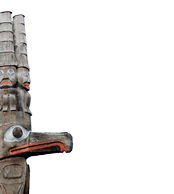 |
|||||||||
 |
|||||||||
 |
|||||||||
Historical Newspaper Activity
Description
Bishop Demers was the first Catholic Bishop of Vancouver Island and was largely responsible for the establishment of St. Anne’s Schoolhouse, which is located on the Thunderbird Park site adjacent to the main Royal British Columbia Museum building. He brought a printing press to Victoria, which forms part of the museum collection and provides a starting point for the activity.
A talk bubble to an archival photograph of Bishop Demers introduces him to the viewer and tells briefly how he came to Victoria in the 19th century. He refers to the hand printing press, which there is also a photograph of. Early newspapers from British Columbia were printed on it and there are PDF file copies of some of them on the site in St Anne’s schoolhouse. Amor De Cosmos takes over the story and tells how he bought the press to publish The British Colonist. He talks about his job as editor. A copy of the December 11, 1858 issue of The British Colonist can be viewed by clicking on the newspaper. De Cosmos continues with more information about the press and introduces the newspaper format for the activity.
The 4-page layout has been condensed to 2 pages. The viewer chooses from four types of articles to write (main news, editorial, news, advertisement) and proceeds to a space within the condensed version of the 4-page December 11, 1858 newspaper. For each type of article, there is written information about what is expected in terms of elements to include (e.g. what the issue is, who did it, where did this event or situation occur, why did this event or situation happen, and how did it happen), purpose of the article, and number of words for this newspaper as well as editing and proofing suggestions.
Once the article has been proofed, the viewer can print it or write another article. The layout allows for one of each type of article to be written with the rest of the paper remaining in its original form.
Typing in your name at the beginning of the activity ensures that your name is on the newspaper as publisher in the printable pages at the end of the activity.
Click HERE to go to activity
TOP of pageLearning Outcomes
Province of British Columbia curriculum samples:
Grade 10 Social Studies
Economy and technology: Canada from 1815 to 1914
Grade 8 English Language Arts
Comprehend and Respond (Engagement and Personal Response)
It is expected that students will identify connections between their own ideas, experiences, and knowledge and a variety of literary and mass media works created by classroom, local, British Columbian, Canadian, and international authors and developers from various cultural communities.
- demonstrate a willingness to explore a variety of genres and media
- identify and explain connections between new ideas and information and their previous beliefs, values, and experiences
- make connections among different texts and media by comparing features, including themes, issues, styles, and appeal
- describe and give examples to explain their personal criteria for assessing and responding to what they view, read, or hear
Grade 9 English Language Arts
Communicate Ideas and Information
(Composing and Creating)
It is expected that students will employ a variety of effective processes and strategies, including the use of electronic technology, to generate, gather, and organize information and ideas.
- develop focussed inquiry questions related to concrete or personal topics for specific audiences and purposes
- locate, access, and select appropriate information from a variety of resources (including technological sources)
- analyse the audience and purpose of their writing to make decisions about content and format
- use a variety of planning tools and strategies to focus and organize communications for various purposes and audiences
- apply various strategies to generate and shape ideas
Suggestions for Use
Research and analyse how changes in communications technology, for example, effected where and how people lived and worked. Write a news item for the paper about it. What difference did the hand printing press make when it was brought to Victoria? What further technological and other changes influenced Canada's economy during the 19th century? Write from different people's perspectives (e.g., settlers, Songhees and Esquimalt First Nations, gold seekers, children).
Compare the format of this 19th century newspaper to contemporary newspapers as part of a study of changing communications.
Choose something in the newspaper that interests or intrigues - research it further, and write about it (e.g., gold rush supplies – find out more, opinion piece, advertise for supplies, factual news items).
Write about other artifacts and exhibits found on the Thunderbird site from the same or different eras. Experiment with writing styles. Use copies of other newspapers and the journals of the Sisters who travelled from Eastern Canada to compose news articles or opinion pieces for your own version of the paper.
Lesson plans and resources related to both printing press communications as well as using newspapers in the classroom are available online from the following sites:
- History of Newspapers http://www.newspaper-industry.org/history.html
- How Newspapers Work http://people.howstuffworks.com/newspaper4.htm
- Newpapers in the Classroom http://www.cdli.ca/CITE/newspapers.htm
- News Writing http://www.learner.org/resources/series44.html
- Newseum http://www.news
- Printing Press http://www.educationworld.com/a_lesson/00-2/lp2178.shtmleum.org/
Sample Lesson Plan - click HERE for PDF file
